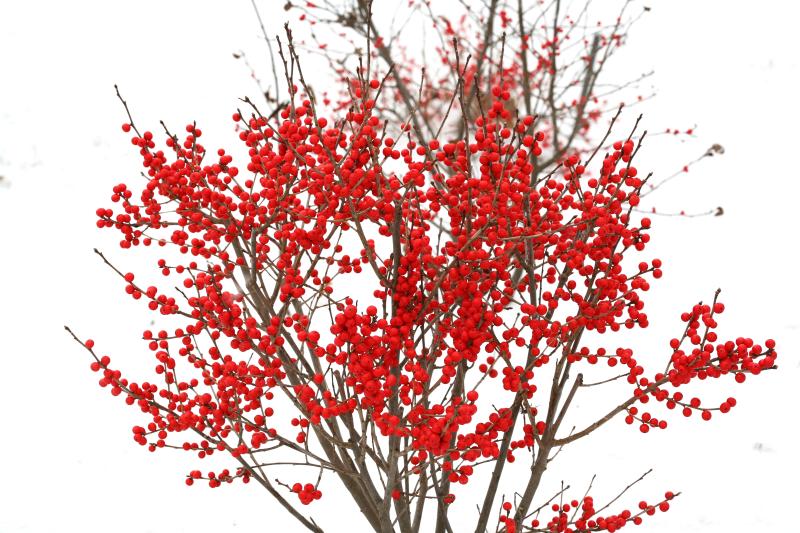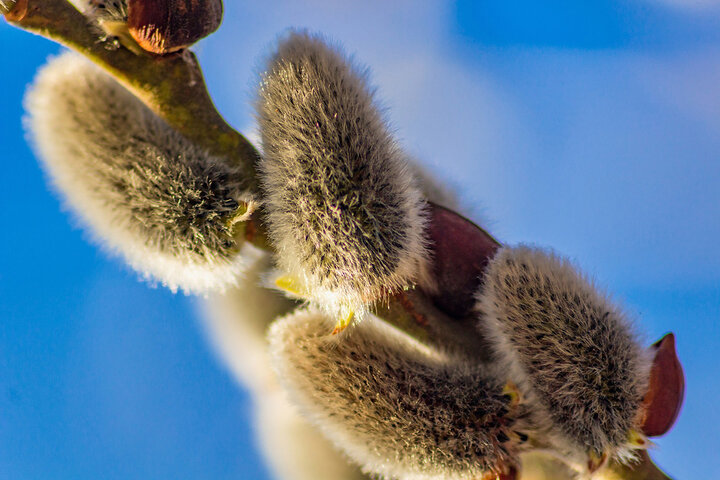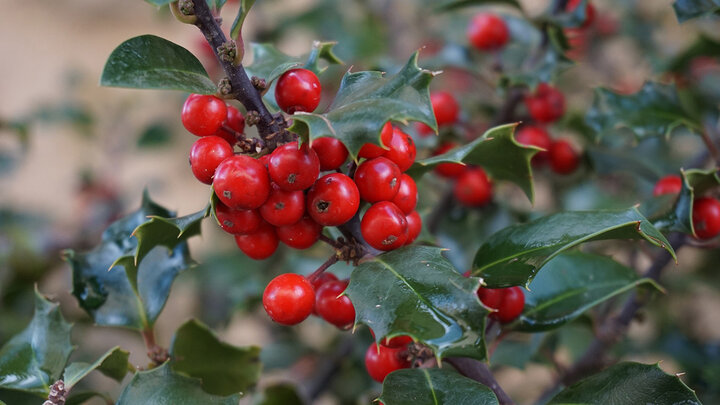Sarah Browning, Nebraska Extension Educator

'Berry Poppins' winterberry holly. Image from Proven Winners.com
Woody floral plants include any woody plant species having colorful or unusually shaped stems, buds, flowers, fruits or leaves. They are given the name "woody florals" because they are often sold to florists for use in flower arrangements. But they also bring interest and color to the home landscape or can be used in home decorations.
Colorful Stems
A group of plants commonly grown for the interesting color of their stems are varieties of Redosier dogwood, Cornus sericea. These plants are woody shrubs that prefer full sun, are adaptable to many soil types and hardy to Zone 2. They reach 7 to 9 feet in height with a spread of 10 feet or more, so they must be allotted enough space to grow well and develop a nice shape.

Maintain their beautiful stem color by pruning out a few of the oldest stems each spring, just before new growth starts. Cut the old stems down at close to the soil as possible. Removing these older stems encourages the crown to continually send up new young stems with bright coloration.
Varieties of redosier dogwood with very colorful stems include:
- ‘Bailey's Red’ or ‘Cheyenne’- bright red stems
- ‘Cardinal’- bright cherry red stems
- ‘Colorado’- orange-red stems
- ‘Flaviramea’ or yellowtwig- chartreuse stems
Another plant with interesting stem color and shape is corkscrew willow, Salix matsudana. Reaching 25 to 30 feet in height with a spread of 15 feet, these plants are really small trees. They also prefer full sun and develop into an oval-rounded canopy with fine-textured twisted and curled branches. Hardy to Zone 5
Additional willows with interesting stems include the following.
- ‘Scarlet Curls’ willow- scarlet red young stems in winter, the older stems are golden brown.
- ‘Golden Curls’ willow- golden yellow stems with a semi-drooping nature. Tends to develop a more shrubby form than Scarlet curls.
- Curly willow ‘Tortuosa’- gnarled and contorted gray-brown branches make a wonderful conversation piece and a great accept in the winter landscape.

Attractive Buds
Pussy willows,Salix caprea, have attractive, fuzzy buds which are a pleasant childhood memory for many gardeners. They are usually treated as a shrub in the home landscape, but unpruned grows into a small tree reaching 15-25 feet at maturity. Its most arresting feature are the 1-2 inch long, fuzzy, whitish buds appearing in March and early April.
Pussy willow stems can also be cut while the dormant buds are still covered with reddish bud scales, and brought into the house where water and warmth causes them to open. Their stems are beautiful additions to home floral arrangements and other decorations.

Other plants in the willow family with attractive buds include:
- Black pussy willow, S. melanostachys, has deep purple-black, fuzzy buds with brick red anthers. It is an unusual and attractive plant that reaches a mature height of 6-10 feet. Zone (4) 5. 'Black Cat' (S. chaenomeloides) is a new cultivar from Proven Winners.
- Rosegold pussy willow, S. gracilistyla, has pinkish or reddish-tinged silky buds, although there is a great deal of variation in the degree of bud coloration and is much rarer than the other willows, so can be very hard to find. Mature height, 6-10 feet. Zone 5
Beautiful Fruits
Plants with attractive fruits, such as bittersweet and holly, are commonly incorporated into fall and holiday decorations. In the plant world, both bittersweet and holly are unusual because they have separate male and female flowers on separate plants. This means that two plants are required, a male to pollinate the female flowers and a female to develop the attractive fruits we desire.

Bittersweet, Celastrus scandens, is a very vigorous twining vine with deep glossy green leaves that needs a lot of space to grow. Not a great plant for small home gardens where it will quickly overrun every small shrub and tree in sight, but nice for rough areas where it can be allowed to scramble over fences or brush piles. Be sure to plant American bittersweet, not the invasive oriental bittersweet, C. orbiculatus.

Traditional holly can be a challenging plant to grow in Nebraska but winterberry holly, Ilex verticillata, is a great alternative. Winterberry is a deciduous holly that loses its leaves in winter, but produces beautiful red berries on bare stems that can be cut and used indoors. Look for females ‘Winter Red’, ‘Red Sprite’, ‘Berry Nice’ or ‘Sparkleberry’ and males ‘Jim Dandy’, ‘Southern Gentleman’ or ‘Apollo’.
Winterberry prefers full or partial sun and moist soils (great for wet areas of the landscape) with high organic matter. However, it is tolerant to clay soil and dry conditions once it is established.
Try one of these great plants to brighten up your winter landscape!
Images/p>
- Redtwig dogwood. Image from Pixabay.com
- Pussy willow buds. Image from Pixabay.com.
- 'Black Cat' pussy willow. Image from Proven Winners.
- Bittersweet, 'Celastrus sandens' Image from Pixabay.com
- Holly 'Ilex verticillata' Image from Pixabay.com